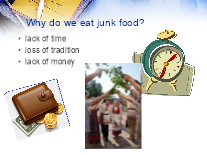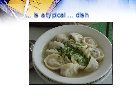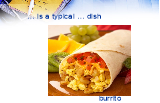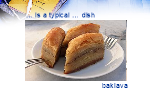Практичне заняття "Традиційна українська кухня"
Інструкційна картка до проведення практичного заняття № 15 (2 год.)
Тема заняття: Традиційна українська кухня. Ukrainian Cuisine
Мета проведення заняття:
Практична:
- навчити замовляти їжу в кафе або ресторані,
- закріпити знання правил мовного етикету;
- закріпити граматичний матеріал: 2-d Conditional;
Розвиваюча:
- поглибити знання учнів про українські кулінарні традиції;
Виховна:
- формувати комунікативну компетенцію студентів;
- виховувати дбайливе ставлення до їжі як до складової свого здоров’я.
Після виконаної роботи студенти повинні:
знати: лексику з теми, мовний етикет
вміти: сприймати іншомовний текст на слух з послідуючим обговоренням, розповісти про традиційну українську страву та технологію її приготування, замовити обід у кафе або ресторані.
Оснащення заняття: магнітофон, лексичні та граматичні таблиці, підручник, мовні кліше, тематичні картинки.
Матеріально-технічне оснащення заняття:
мультимедійна система, підручник, граматичний довідник, лексичні таблиці, методичні вказівки до практичного заняття, робочий лист студента
Рекомендована література:
Основна:
- Карп’юк О.Д. Англійська мова:Підручник для 11 класу загальноосвітніх навчальних закладів. Рівень стандарту. - Тернопіль: Видавництво «Астон», 2011. -296с.: іл.
- Плахотник В.М. «Англійська мова». Підручник для 10 класу середньої школи. - К.: «Освіта»,1997. - 222 с.
Допоміжна:
https://learnenglish.britishcouncil.org
План заняття:
1 Організаційна частина заняття – 10 хв.
1.1 Перевірка присутності студентів
1.2 Повідомлення теми, мети заняття
T: Today the topic of the lesson is Ukrainian Cuisine “Having meals at a café or in a restaurant” . By the end of the lesson you’ll be able to learn how to order meals if you are eating out. It’ll help you to enquire a command of the spoken English. Besides you’ll extend active and passive knowledge of vocabulary and talk about Ukrainian traditional meals.
1.3 Мотивація навчальної діяльності. Повідомлення критеріїв оцінювання
Today we are going to talk about national cuisine and do some grammar exercises. So look at the screen where you can read the topic of our lesson “ National Cuisine. The Second Conditional.”Warming upT: People can not live without food. But we should remember that We eat to live, but we do not live to eat.
1.4 Актуалізація опорних знань студентів
-Коротка бесіда про ставлення до їжі та харчових продуктів
What kinds of food do you know?
Why do people eat fast food or junk food?
Why should people eat healthy food?
What can you say about junk food?
2 Основна частина заняття – 60 хв.
2.1 Активізація лексичного матеріалу по темі. (10 хв.) Pudding is a typical English dish Pizza is a typical Italian dish. Varenyky is a typical Ukrainian dish. Pelmeni is a typical Russian dish. Burrito is a typical Mexican dish. Ratatouille is a typical French dish Sushi is a typical Japanese dish. Baklava is a typical Turkish dish.
2.2 Пред’явлення текстy для читання “Ukrainian Cuisine” (20хв.)
2.3 Повторення та узагальнення грам матеріалу «Conditionals» (20 хв.)
2.4 Формування письмових навичок(10 хв.)
3 Узагальнення. Підведення підсумків, оцінювання студентів – 5 хв.
- What was the topic of our lesson today?
- What new words have you remembered best of all? (4-6 at least)
- What grammar rule have we revised today?
4 Повідомлення та пояснення домашнього завдання – 5 хв.
4.1 Learn the new words.
4.2 1 Practice writing a recipe of a famous Ukrainian dish. It is borsch. This recipe is not going to have any lam or beef, it is vegan and absolutely delicious. Then you will have to put the sentences in the correct order.
- Add 2 tablespoons of minced fresh dill.
- Add chopped celery and carrot.
- Add 2 cloves of chopped garlic.
- Pour 1 or 2 tablespoons of oil into the pan.
- Stir and leave for 5 or 7 min.
- Add one medium chopped onion.
- Serve with 1 tablespoon of sour cream
- Add 3 cups of vegetable stock
- Peel and cut into cubes three medium beets.
- Add beets, potatoes and macintosh apple, combine everything.
Практичне заняття № 15
Тема заняття: Традиційна українська кухня. Ukrainian Cuisine
Task 1 What food do you prefer?
1.1




1.3 Every country has its own cuisine. Some popular dishes are associated with this or that national cuisine. Remember such dishes. Complete the sentences.
|
|
|
|
|
|
|
|
|
|
|
|
|
|
Pizza is a typical Italian dish.
1 2 3 4








. 1.2 Complete the sentences with the adjectives from the box:
![]() fresh, frozen, home – made, low – fat, raw, spicy, sweet, takeaway.
fresh, frozen, home – made, low – fat, raw, spicy, sweet, takeaway.
1 Food which is kept very cold is …
2 These eggs are …, I bought them today.
3 I like my mum’s cooking. … food is always the best.
4 This tea is very …. You have put too much sugar in it.
5 Indian food like curry is very ….
6 … food is food you buy at a restaurant and take home to eat.
7 Sushi is made with … fish.
8 People on a diet often try to eat … food.
Task 2 Reading
2.1 Read and understand the text
“Ukrainian Cuisine”
Ukrainian food is one of the richest national cuisines. Its dishes are well known far away from Ukraine. And the Ukrainian recipes of the foods are very popular nowadays. Is anyone, who doesn’t know the Ukrainian Borsch?
Borsch is cooked of fresh vegetables: cabbage, beet, tomato with the addition of pounded lard with garlic and parsley. The combination of all these groceries give the borsch its piquancy, aroma and unforgettable taste. There are about 30 types of Ukrainian borsch: Poltava borsch, Chernigov borsch, Kiev borsch, Volyn borsch, Lviv borsch and others.
Varenyky are very popular in Ukraine too. They are ravioli-like pasta stuffed with potato, cabbage, mushrooms, meat or cheese, or with cherries as a sweet dish.
Stewed meat with potatoes, Ukrainian bitki with garlic and lard, stewed cold boiled pork with cabbage and lard, krucheniki and others have the same popularity among Ukrainian lovers of tasty food.
The description of Ukrainian cuisine would be incomplete without salo (pork fat). Ukrainians regularly joke, "Salo is our national pride". Placing a thin sliced salo on black bread with garlic and salt is a quick and simple way to a delicious snack.
Ukrainian food is simple and complex at the same time.
2.2 Answer the questions to the text:
- What are the most popular vegetables in Ukraine?
- How many types of Ukrainian borsch are there?
- Name traditional Easter bread.
- What symbols is the top of the paska decorated?
- Ukrainian food is simple and complex at the same time, isn’t it?
2.3 Choose A, B, C, D to answer the questions or to fill in the blanks.
1) __________ is a brawn made from boiling pigs’ trotters.
A borshch B kholodets C salo D domashnia kovbasa
2) What is unnecessary for cooking borshch?
A onion B potato C rice D carrot
3) There are about ______________of Ukrainian borsch
A three B third C thirty D thirty-three
4) It is eaten in thin slices on black bread with garlic and salt. Especially delicious is the smoked version.
A Pork fat B chicken fat C beef fat D veal fat
Task 3 Grammar «Умовні речення 2-го типу»
We use 2nd Conditional to express things which are very unlikely or impossible. We can also use it to describe imaginary actions for unsatisfied conditions in the present. 2nd Conditional = if + Past Simple + would/could + Infinitive
3.1 Make up a sentence using the table.
|
Englishman sausage |
|
Indian pudding |
|
If I were German I would choose curry |
|
Italian rice |
|
Chinese spaghetti |
|
Frenchman sauces |




3.2 Complete the sentences by changing the verbs in brackets to make 2-d Conditional.
1 If I (be) in Bukovyna, I (help) myself to brynza.
2 If I (have) some dried fruit, I (make) uzvar or kysil.
3 I (can make) kvas if I (have) some dried bread.
4 If you (be) in Poltava, you (be invited) to taste Ukrainian borshch with halushky.
5 If you (ask) me what dessert I would like to have, I (mention) about apple pie first.
Task 4 Oral Practice
4.1 Find some information about these dishes.

borshch, varenyky, holubtsi, deruny, kholodets, salo, mlyntsy, domashnia kovbasa
- It is brawn made from boiling pigs” trotters. The meat is picked off the born and the gravy sets around it into a jelly as it cools; served with horseradish or mustard
- Pancakes, often made with soured milk for a lighter batter. Thinner pancakes are called nalysnyky, which are rolled and served with a stuffing, usually fruit and jam.
- Cabbage rolls stuffed with rice and vegetables, or possibly with spiced minced meat, and stewed slowly in the oven.
- Soup based on beetroot with meat and other vegetables; served with sour cream. There are many regional varieties.
- Pork fat – no description of Ukrainian cuisine would be complete without it. Ukrainians like their pigs to be fat for it. Spices are rubbed into the skin. It is eaten in thin slices on black bread with garlic and salt. Especially delicious is the smoked version.
- Ravioli – like pasts stuffed with potato, cabbage, mushrooms, meat or cheese, or with cherries as a sweet dish.
- A domestic sausage, but it can not be called saliami. The only way to sample true home – prepared sausage is by experiencing it for yourself with the sights and smells of the markets of Ukraine.
- Pancakes made from grated potato and flour and fried; served with sour cream.
4.2
|
|
|
|
|
|
|
|
4.3 Translate into English
- Українська кухня має багату історію і пропонує багато смачних страв.
- Українська кухня має десятки тисяч рецептів їжі.
- Українській борщ має багато різних рецептів.
- Традиційний український борщ - містить 20 компонентів.
- Популярні інгредієнти кухні України - м'ясо, гриби, овочі, ягоди, фрукти та зелень.
1


про публікацію авторської розробки
Додати розробку
